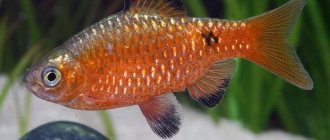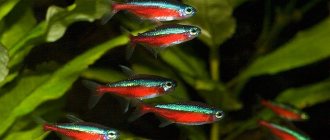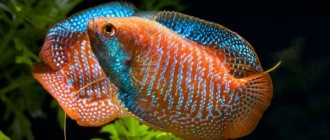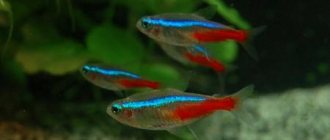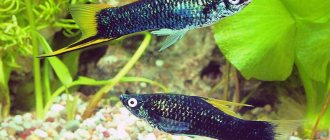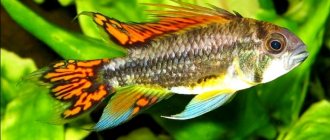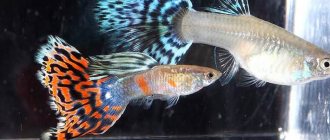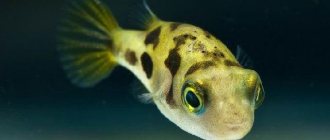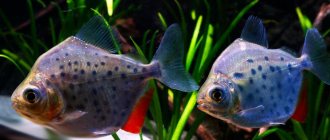The iris or melanotenia is a true decoration of the home aquarium. These peaceful Australian fish are suitable for those who already have experience in keeping aquarium fish and are familiar with concepts such as temperature, hardness, and acidity. Rainbowfish can be very sensitive to water parameters. But a flock of a dozen of these fish can distract the owner and help him relax after a hard day at work.
Appearance
Australians, exotic to our region, number about 80 species. Many of them do well in the home aquarium. But when choosing, it is important to find out the usual temperature parameters of each species that is planned to be placed in the biotope. An incorrectly chosen temperature will shorten the lifespan of iris in the aquarium, and inappropriate acidity or hardness can even kill them.
Common signs for all iris:
- Laterally flattened oblong body
- Bright color
- Dimensions on average 8-10 cm
- The dorsal fin has several short rays, which is why it seems to split into two unequal parts: the one closer to the tail is longer. The short part of some species has a bizarre shape
- The caudal fin has clear bifurcated contours: in the middle its rays are shorter than at the edges, resulting in a typical “fish tail”
- The mouth is small, it has small teeth, suitable only for eating live food. With such teeth, the iris will not defend itself or attack
Description
The size of irises in an aquarium is 5–16 cm (depending on the variety). The body shape of aquarium fish is flattened on the sides and slightly elongated. The anal fin is wide, and the dorsal fin is narrow, divided into two parts. The tail is forked. These handsome creatures with large eyes can boast of a variety of appearances: the body comes in different colors, and the fins are sometimes wonderfully shaped.
Melanothenia is also non-conflict. They are very peaceful and get along well with other calm inhabitants. They are active and love to swim throughout the water. They live 5-8 years in an aquarium.
They are also found in water bodies of Australia, New Guinea and Indonesia. Natural varieties are considered endangered.
Kinds
Let us list the most common types of iris.
- Boesman's iris has two primary colors. The front half of her body is deep blue, and her tail is bright orange. The fish shimmers with the colors of the rainbow. The eyes are black. Grows up to 7-10 cm. Heat-loving, comfortable temperature for it is 25-29°C.
- Iris popondetta - has a small size, black and yellow body color, non-standard shaped fins (the spinal fin is clearly divided into two, and they have different shapes). Blue eyes stand out especially effectively against a yellow background. Comfort temperature – 24-28°C.
- The iris is three-striped - a black stripe stretches along the body on the sides from the head to the tail. The main body shade is red. Above and below the black stripe there are bluish-greenish stripes that flicker in good light. To ensure that the three-striped beauty does not lose color in captivity, she should choose a more spacious aquarium. Comfortable temperature 22-25°C.
- Turquoise iris, melanotenia, is endemic to New Guinea's Lake Kutubu. The body shape is standard for iris, the color is shimmering blue, turning into green. Shimmers from silver to deep purple. Comfortable temperature 22-25°C.
- Neon iris - has a slightly more elongated body compared to more typical representatives. The color shimmers with a neon glow. To emphasize this feature of the scales to reflect light, you need to organize high-quality lighting in the aquarium. Temperature 22-28°C.
- The iris Glossolepis (crested iris, red silverside) grows in the range of 6-12 cm, has a red body color with a golden tint. The head is somewhat elongated. It is the most timid of the irises, sensitive primarily to the level of acidity (6-7). Temperature 23-27°C.
- Melanothenia Duboulay - has a yellow-green color and a contrasting black edging on the fins. Compared to other species of iris, it has a fairly short lifespan (up to 4 years in nature). Prefers a temperature of 22-25°C.
- Blue iris, melanotenia humpback - has a more rounded body, with a small, slightly elongated head. The color is predominantly pearlescent, with slight transitions to red, green and other bright colors. It grows up to 14 cm, this should be taken into account when choosing the size of the aquarium.
- Blecher's iris is an active fish of medium size for iris - 7-9 cm. Color - silver, golden or greenish-pearl. Loves natural light and sunlight (which should be taken into account not only when choosing the location of the aquarium, but also when maintaining and caring for it. The more sunlight, the more often you will have to clean the walls from green deposits). Comfort temperature 23-28°C
General information about neon iris
The neon rainbowfish, or neon melanotenia, is a ray-finned fish that lives in fresh water. Belongs to the Melanothenia family.
It gained its popularity among aquarists for several reasons.
- Bright and attractive color with mother-of-pearl and neon reflection.
- Active behavior.
- Gets along with various types of aquarium inhabitants.
- Reproduces quickly and easily even in captivity.
Neon iris is very popular among aquarists. Unlike other members of the family, this fish has a very modest size, so it can often be called a dwarf iris.
Maintenance and care
- The volume of the aquarium is a minimum of 50 liters per flock of 6 individuals. Ideally, of course, 70-80 liters for the same amount. The fish should feel free. The larger the flock, the more spacious the aquarium
- Weekly water changes of approximately a quarter of the total volume, and along with them - cleaning the soil with a special siphon
- Be sure to have a lid on the aquarium: irises can jump out
Water parameters
- Temperature 22-28°C. More precise parameters depend on the specific type
- Hardness 5-16
- Acidity 6.5-7.5
Decor and plants
- It is better to place decor and plants closer to the walls of the aquarium, leaving room for free swimming
- Driftwood, living plants and a dark background are suitable as decoration. In such an environment, the iris looks most impressive
How long do rainbowfish live in an aquarium? Their life expectancy, subject to general conditions of detention and careful attention to each specific species, is 4-7 years.
Interesting Facts
Rainbow fish are considered one of the most beautiful inhabitants of home artificial ponds. But the brightness of their color depends not only on their state of health, it is also influenced by their mood.
If there is a stressful situation in the aquarium, then the entire flock immediately becomes dull. So these fish can safely be called a barometer of the psychological situation of the underwater environment.
But as soon as the adaptation period passes, the acid-base balance is leveled out, and the water temperature stops jumping, the irises immediately begin to shimmer with all the colors of the rainbow, especially in natural sunlight.
Feeding
Rainbowfish eat well both dry and live food. “Freezing” will also suit them. It is better if the feeding is varied, with the presence of both species. Live and frozen food helps increase immunity and the body's resistance to certain diseases. Feeding dry food is necessary in order to maintain color, as well as saturate the body of a small fish with the necessary amount of vitamins. If they are missing, iris will eat living plants. It is better to choose food that sinks slowly. The rainbowfish is not very keen to collect the uneaten food from the bottom.
Behavior and Compatibility
The habitat of these creatures is the tropical waters of New Zealand and Australia. There, irises are very common. A typical biotope for them is fresh or slightly brackish lakes with warm water and rich vegetation. They are peaceful and vulnerable, as they have no means of defense (shell, teeth, spines, etc.). Therefore, a monospecies aquarium with iris would be ideal. A biotope in which only irises will swim, and one or two catfish, which will be able to keep the bottom clean. Catfish should also be calm and peaceful. For example, speckled ones.
If a monospecies fish seems too boring, you can choose the same peaceful fish with similar maintenance parameters as neighbors: barbs, thorns, cardinals, platies, and so on. Compatibility with predators, even small ones, is impossible for iris.
Habitat in nature
Melanothenia three-stripe was first described by Randall in 1922. It lives in Australia, mainly in the northern part.
Its habitats are very limited: Melville, Mary River, Arnhem Land, and Groote Island. As a rule, they live in streams and lakes abundantly overgrown with plants, gathering in flocks, like other representatives.
But they are also found in rivers, swamps, even drying up puddles during the dry season. The soil in such places is rocky, covered with fallen leaves.
Reproduction and breeding
If you keep iris for the purpose of breeding, then two important conditions must be met. The first is the ratio of individuals by sex. There should be one more female than male.
The second condition for an excellent breeding result is that the fish must be of the same species. Interspecific crossing, if it produces results, is unpredictable: loss of color, low survival rate and high mortality of fry.
If there is no goal to breed iris, then you can increase the number of males, because they look brighter and more impressive.
Reproduction of rainbowfish at home requires transplanting the future parents into a spawning tank, separate from the rest of the flock. The spawning tank can be smaller than the main aquarium, but with a filter, aeration and a small amount of decoration: plants with small leaves, tangle or synthetic mesh.
Rainbowfish are seasonal fish. Therefore, you need to start preparing for spawning by simulating the right time of year. How? Changing your diet. A pair of male and female are placed in the spawning tank and are offered a variety of fresh food, mostly live. Rich food triggers the reproduction process of iris. The male fertilizes the female, after which the spawning process begins. It lasts several days, with each day the female releases more and more eggs. When the number of eggs begins to decrease, it is better to return the fish to the general aquarium so as not to completely deplete them.
The eggs cling to the leaves and threads of the fishing line at the bottom. After three to four days, the fry appear and are fed according to a typical scheme: ciliates, artemia nauplii, and a transition to larger food for the fry.
Sexual dimorphism
Sexual dimorphism is quite well expressed, males are usually larger than females and brighter in color, their body is noticeably taller, especially in mature individuals. The front part of their dorsal fin, when folded, extends beyond the beginning of its back part. The posterior edge of the dorsal and anal fins in females is usually more rounded than in males. The color palette of females of most species is shifted towards grayish-brown tones.
Males are usually larger than females and brighter in color, their body is noticeably taller, especially in mature individuals
At an early age, it is quite difficult to distinguish the sex of iris . To avoid having a predominance of dull females instead of bright males in the aquarium, the best option is to buy juveniles at the age stage at which the beginnings of future differences in the color of the sexes are already beginning to appear.
If there are none yet, the fry should be taken in reserve, subsequently leaving in the aquarium the number of fish required in terms of color and the ratio of different sexes.
Rainbows mature in 8-12 months. Sexual dimorphism begins to appear at about six months of age.
Diseases
The main diseases to which rainbowfish are susceptible are related to diet and food quality. If you feed mainly bloodworms and tubifex, then parasites or infections may be introduced into the intestines. Skin parasites are also introduced with live food or with new neighbors who have not undergone quarantine. If live food is excluded, the fish will not have enough immunity to resist fungal diseases. Prevention of diseases can be called maintaining the necessary water parameters, regular cleaning, aeration and constant filtration.
